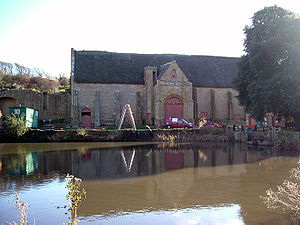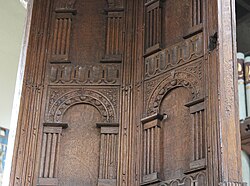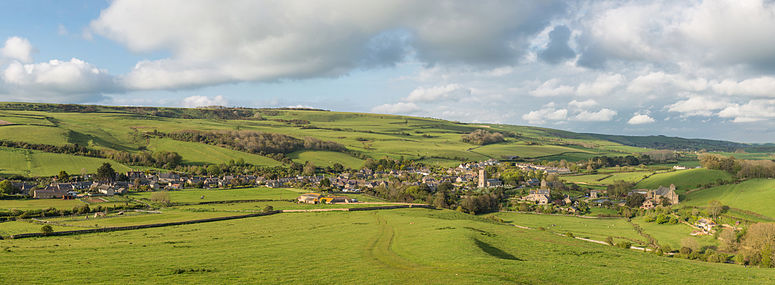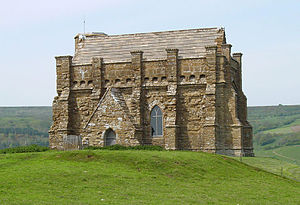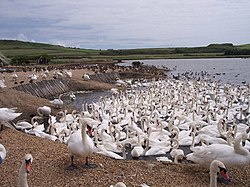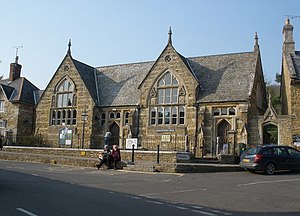Abbotsbury
| Abbotsbury | |
| Dorset | |
|---|---|
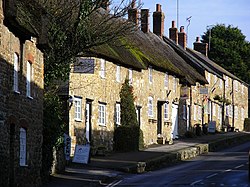 Rodden Row, Abbotsbury | |
| Location | |
| Grid reference: | SY576853 |
| Location: | 50°39’59"N, 2°36’2"W |
| Data | |
| Population: | 481 |
| Post town: | Weymouth |
| Postcode: | DT3 |
| Dialling code: | 01305 |
| Local Government | |
| Council: | Dorset |
| Parliamentary constituency: |
West Dorset |
| Website: | http://www.abbotsbury.co.uk/ |
Abbotsbury is a village and parish in Dorset, situated about a mile inland from the English Channel coast. In the 2011 census the civil parish had a population of 481.
The coastline within Abbotsbury parish includes a section of Chesil Beach, an 18-mile barrier beach which is part of the Jurassic Coast, a World Heritage Site.
Abbotsbury is known for its swannery, subtropical gardens and surviving abbey buildings, including St Catherine's Chapel, a 14th-century pilgrimage chapel that stands on a hill between the village and the coast.
Much of Abbotsbury, including Chesil Beach, the swannery and subtropical gardens, is owned by the Ilchester Estate, which owns 15,000 acres of land in Dorset.
Contents
Description
The village of Abbotsbury comprises a long street of stone houses,[2] many of which are thatched, with some dating from the 16th century.[3][4] The street broadens at one point into an old market square.[3] Parts of the street have a raised pavement.[5] The village is surrounded by hills on all sides, except to the east; in 1905 Sir Frederick Treves described Abbotsbury as being "very pleasantly situated among the downs".[4] Dorset-born broadcaster and writer Ralph Wightman described the village as "possibly the most interesting in Dorset".[2]
The B3157 road between Abbotsbury and Burton Bradstock is notable for its fine coastal views.[6]
History
One and a half miles north-west of the village, at the top of Wears Hill, are the earthworks of Abbotsbury Castle, an Iron Age hill fort.[7] The earthworks cover a roughly triangular area of about 10.0 acres (4.0 ha), of which about 4.5 acres (1.8 ha) are inside the ramparts.[8]
In the 10th century a charter of King Edmund records a granting of land at Abbedesburi,[9] a name which indicates the land may have once belonged to an abbot.[9] In the 11th century King Cnut granted land at nearby Portesham to the Scandinavian thegn Orc (also Urki, Urk), who took up residence in the area with his wife Tola.[10] The couple founded Abbotsbury Abbey and enriched it with a substantial amount of land.[10]
In 1086 in the Domesday Book Abbotsbury was recorded as Abedesberie or Abodesberie;[11] it had 62 households, 16 ploughlands, 32 acres of meadow and 2 mills. It was recorded in the hundred of Uggescombe and the lords and tenants-in-chief were Abbotsbury Abbey and Hawise, wife of Hugh son of Grip.[12]
Abbotsbury Abbey existed for 500 years, but was destroyed in the dissolution, although the abbey barn survived. Stone from the abbey was used in the construction of many buildings in the village,[2] including the house of Abbotsbury's new owner, Sir Giles Strangways.[6]
In 1664, during the Civil War, Roundheads (Parliamentarians) and Cavaliers (Royalists) clashed at Abbotsbury. Parliamentarians besieged the Royalists in the church of St Nicholas;[13] two bullet holes from the fight remain in the Jacobean pulpit.[6] The Strangways house which had replaced the Abbey after the dissolution was also the scene of a skirmish, as the Royalist Colonel Strangways resisted the Parliamentarians, who besieged the house and burned it. The house gunpowder store exploded in the fire and the house was destroyed,[6] together with the old abbey records which had been stored there.[14]
In the late 17th and early 18th centuries Abbotsbury experienced several fires, resulting in the destruction of virtually all its mediæval buildings. Most of the historic secular buildings in the village today were built from stone in the 17th and 18th centuries.[15]
County historian John Hutchins (1698–1773) recorded that fishing was the main industry in the village, and 18th-century militia ballot lists reveal that husbandry was also particularly important. Ropemaking, basketry and the manufacture of cotton stockings were other notable trades within the village, with records indicating hemp and withies being grown in the area.[15]
In the early 19th century Abbotsbury's population grew steadily, from about 800 in 1801 to nearly 1,100 sixty years later.[15]
Between 1885 and 1952 Abbotsbury was served by the Abbotsbury Railway, a six-mile branch from the main line to Weymouth. It was primarily designed for freight, in anticipation of the development of oil shale deposits and stone at Portesham, as well as iron ore at Abbotsbury which would be shipped to South Wales for processing. The Abbotsbury terminus of the line was inconveniently sited a mile east of the village because the railway could not buy the land needed to build the station closer to the village.[16]
During the Second World War, the coastal front was fortified and defended as a part of British anti-invasion preparations.[17][18] Later, The Fleet Lagoon was used as a machine gun training range, and bouncing bombs were tested there, for Operation Chastise (the "Dambuster" sortie).
Notable buildings
Nearly a hundred structures within the parish are listed for their historic or architectural interest. These include six structures listed as Grade I and six listed as Grade II*.[19]
To the south of the village, on a bare hill about 260 ft high, stands St Catherine's Chapel, a small 14th-century pilgrimage chapel used by the monks of the abbey as a place for private prayer.[20] It is built entirely of stone, including the roof and even the panelled ceiling.[6] The walls four feet thick and buttressed. The chapel overlooks the English Channel, and may have served as a beacon for sailors, warning of the nearby Isle of Portland. The chapel is listed as Grade I.[21]
The Parish Church of St Nicholas dates from the 14th century but has had various revisions over the centuries. The tower contains three bells dating from 1773 and made by Thomas Castleman Bilbie of the Bilbie family in Cullompton.[22] The chancel was classicised in the 18th century and still has its plastered barrel roof and fine altarpiece. There are also some 15th-century painted glass, a stone effigy of one of the abbots and a Jacobean canopied pulpit.[23] The church is listed as Grade I.[24]
Abbotsbury Abbey tithe barn was built around 1400. It measures 270 feet by 30 feet and is the world's largest thatched tithe barn.[8][25] It has 23 bays, 11 of which have been unroofed since the 17th century. The 12 roofed bays are covered with thatch, though previously stone slabs were used. Part of the north wall has been destroyed. The barn is listed as Grade I.[26]
Ilchester Estate
An estate of some 15,000 acres in Dorset covering Chesil Beach and Abbotsbury is held by the Ilchester Estate, owned by Mrs Charlotte Townshend, the daughter of Viscount Galway, a descendant of the first Countess of Ilchester and owner of the Melbury Estate.
Swannery
Situated south of the village on the shore of the Fleet lagoon, Abbotsbury Swannery is over 600 years old, having previously been owned by the abbot and managed, using decoys, to provide meat for the abbey. When the abbey was destroyed the swannery passed to the earls of Ilchester,[2] and today the decoys are used for monitoring and recording purposes.[6] The swannery has a large colony of mute swans, as well as other waterfowl, and is open to the public. The site is an important nesting and breeding ground for the swans and, from May through the summer, cygnets can be seen at close quarters.
Subtropical gardens
Abbotsbury Subtropical Gardens were founded in 1765 by the Countess of Ilchester, as a kitchen garden for the nearby castle.[27] Since then, the gardens have developed into a 20-acre site filled with exotic plants, many of which were newly discovered species when they were first introduced. There are formal and informal gardens, with woodland walks and walled gardens. In 1990 violent storms damaged many of the rare specimens, which have since been replaced by younger plants.[28]
Amenities
Abbotsbury has a village hall, called the Strangways Village Hall; it is run by the Strangways Hall Committee and is a registered charity and available for hire.[29] The village has two public houses, The Ilchester Arms[30] and The Swan Inn, and several tearooms, small shops and businesses. The village also has a cricket ground.[31]
Notes
- ↑ "Area: Abbotsbury (Parish), Key Figures for 2011 Census: Key Statistics". Neighbourhood Statistics. Office for National Statistics. http://www.neighbourhood.statistics.gov.uk/dissemination/LeadKeyFigures.do?a=7&b=11119769&c=Abbotsbury&d=16&e=62&g=6418379&i=1001x1003x1032x1004&m=0&r=1&s=1401609522545&enc=1. Retrieved 1 June 2014.
- ↑ 2.0 2.1 2.2 2.3 Ralph Wightman (1983). Portrait of Dorset (4 ed.). Robert Hale Ltd. p. 169. ISBN 0-7090-0844-9.
- ↑ 3.0 3.1 "A Tour of Abbotsbury". abbotsbury.co.uk. 2013. http://www.abbotsbury.co.uk/abbotsbury-tour.htm. Retrieved 19 September 2013.
- ↑ 4.0 4.1 Treves, p. 240
- ↑ John Hyams (1975). The Batsford Colour Book of Dorset. B. T. Batsford Ltd. p. 20. ISBN 0-7134-3006-0.
- ↑ 6.0 6.1 6.2 6.3 6.4 6.5 Roland Gant (1980). Dorset Villages. Robert Hale Ltd. pp. 165–7. ISBN 0-7091-8135-3.
- ↑ West Dorset Holiday and Tourist Guide. West Dorset Council. c. 1983. p. 2.
- ↑ 8.0 8.1 "An Inventory of the Ancient and Historical Monuments in West Dorset. Abbotsbury". British History Online. University of London. 2013. http://www.british-history.ac.uk/report.aspx?compid=127186. Retrieved 17 September 2013.
- ↑ 9.0 9.1 Keynes, "The lost cartulary of Abbotsbury", p. 207.
- ↑ 10.0 10.1 Keynes, "The lost cartulary of Abbotsbury", p. 208.
- ↑ "Dorset A-G". The Domesday Book Online. domesdaybook.co.uk. http://www.domesdaybook.co.uk/dorset1.html. Retrieved 24 March 2015.
- ↑ "Place: Abbotsbury". Open Domesday. opendomesday.org. http://opendomesday.org/place/SY5785/abbotsbury/. Retrieved 24 March 2015.
- ↑ Treves, p242
- ↑ "Houses of Benedictine monks 1. The Abbey of Abbotsbury". British History Online. 2013. http://www.british-history.ac.uk/report.aspx?compid=40138. Retrieved 17 September 2013.
- ↑ 15.0 15.1 15.2 "Dorset Historic Towns Survey, Abbotsbury. Post-medieval Abbotsbury (1540–1849)". Dorset Council. http://www.dorsetforyou.com/media.jsp?mediaid=163421&filetype=pdf. Retrieved 19 September 2013.
- ↑ "Abbotsbury". Disused Stations: Closed Railway Stations in the UK. http://www.disused-stations.org.uk/a/abbotsbury/index.shtml. Retrieved 23 December 2012.
- ↑ Foot, 2006, p 57–63
- ↑ "Pillbox FW3/26 Abbotsbury". tracesofwar.com. http://en.tracesofwar.com/article/23796/Pillbox-FW3-26-Abbotsbury.htm. Retrieved 18 June 2013.
- ↑ "Listed Buildings in Abbotsbury, Dorset, England". British Listed Buildings. http://www.britishlistedbuildings.co.uk/england/dorset/abbotsbury. Retrieved 19 September 2013.
- ↑ "History and research: Abbotsbury St Catherine's Chapel". English Heritage. http://www.english-heritage.org.uk/daysout/properties/abbotsbury-st-catherines-chapel/history-and-research/. Retrieved 15 September 2013.
- ↑ "Chapel of St Catherine - Abbotsbury - Dorset - England". British Listed Buildings. http://www.britishlistedbuildings.co.uk/en-105189-chapel-of-st-catherine-abbotsbury-dorset. Retrieved 1 June 2014.
- ↑ Moore, James; Roy Rice; Ernest Hucker (1995). Bilbie and the Chew Valley clock makers. The authors. ISBN 0-9526702-0-8.
- ↑ Betjeman, John, ed. (1968) Collins Pocket Guide to English Parish Churches; the South. London: Collins; p. 171
- ↑ "Parish Church of St Nicholas". Images of England. http://www.imagesofengland.org.uk/details/default.aspx?id=105132. Retrieved 5 October 2007.
- ↑ "Abbotsbury". jurassiccoast.org. 2012. http://jurassiccoast.org/visiting-the-coast/gateway-towns/445-abbotsbury. Retrieved 14 September 2013.
- ↑ "Tithe Barn, Abbotsbury". British Listed Buildings. britishlistedbuildings.co.uk. http://www.britishlistedbuildings.co.uk/en-105139-tithe-barn-abbotsbury-dorset. Retrieved 24 March 2015.
- ↑ Cumming, Ed (23 March 2012). "Subtropical garden wins the HHA/Christie's award". The Telegraph. http://www.telegraph.co.uk/journalists/ed-cumming/9160415/Subtropical-garden-wins-the-HHAChristies-award.html. Retrieved 26 May 2013.
- ↑ "Chainsaw art at Abbotsbury Sub-tropical Gardens". Dorset Echo. http://www.dorsetecho.co.uk/news/8091295.Chainsaw_art_at_Abbotsbury_Sub_tropical_Gardens/. Retrieved 15 September 2013.
- ↑ "Strangways Village Hall, Abbotsbury". abbotsbury.co.uk. http://www.abbotsbury.co.uk/strangways_hall_leaflet_1.pdf. Retrieved 24 March 2015.
- ↑ "The Ilchester Arms Hotel". theilchester.co.uk. http://www.theilchester.co.uk/. Retrieved 24 March 2015.
- ↑ "Abbotsbury CC". abbotsbury.play-cricket.com. http://abbotsbury.play-cricket.com/website/web_pages/176437. Retrieved 24 March 2015.
General references
- Foot, William (2006). Beaches, fields, streets, and hills ... the anti-invasion landscapes of England, 1940. Council for British Archaeology. ISBN 1-902771-53-2.
- Pitt-Rivers, Michael, 1968. Dorset. London: Faber & Faber.
- Taylor, Christopher, 1970. The Making of the Dorset Landscape. London: Hodder & Stoughton.
- Treves, Sir Frederick (1905). Highways and Byways in Dorset. Macmillan & Co. Ltd.
- Keynes, Simon (1989). "The Lost Cartulary of Abbotsbury". Anglo-Saxon England 18: 207–43.
Outside links
- Abbotsbury village website, produced by Abbotsbury Tourism & Traders Association
- Old photographs of the village
